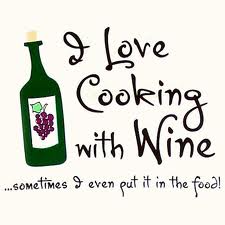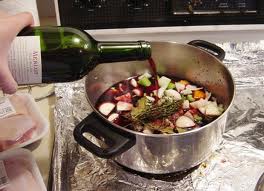Although “cooking wine” is sold in supermarkets across America, I would never use it for cooking. The myth that “since wine evaporates while cooking no one can tell the difference” is  flat wrong. If this were the case, why bother cooking with wine at all? Yes, many sulfates disappear during the cooking process; however, a wine’s essence and characteristic flavor remain, no matter how faint! Because of this, if you use a cheap “cooking wine” your meal will turn out less-than-desirable. Take it from me: cooking wines are extremely salty! Plus, they often contain additional ingredients that will taint the taste of your dish. If you can’t stomach a wine on its own, cooking with it will certainly not improve your meal. So snag a decent bottle out of your wine cellar or wine cabinet, or make use of a day-old half bottle from the fridge--the one case where a wine you won't drink is okay to cook with.
flat wrong. If this were the case, why bother cooking with wine at all? Yes, many sulfates disappear during the cooking process; however, a wine’s essence and characteristic flavor remain, no matter how faint! Because of this, if you use a cheap “cooking wine” your meal will turn out less-than-desirable. Take it from me: cooking wines are extremely salty! Plus, they often contain additional ingredients that will taint the taste of your dish. If you can’t stomach a wine on its own, cooking with it will certainly not improve your meal. So snag a decent bottle out of your wine cellar or wine cabinet, or make use of a day-old half bottle from the fridge--the one case where a wine you won't drink is okay to cook with.
If you’re a little creative, wine can easily liven up just about any food. Here are a few quick ideas you can use in the kitchen when inspiration strikes: drizzle a dry red over a heavy, red meat; add warm wine to meat or poultry to tenderize it more; glaze meats with a butter and wine mixture; substitute wine for water (but don't do this when making rice!); make a baste from your favorite wine and oil to use on meat and poultry...if you have a favorite way to cook with wine, share it in the comments!
 Discovering the “right” amount of wine to use in every dish takes time and experience. When beginning, it’s best to start with a little and add more as desired. Sample your dish as needed until you’re satisfied. Enjoy! Check out these past blogs containing a mouthwatering steak and wine recipe, and a well-known French chicken dish.
Discovering the “right” amount of wine to use in every dish takes time and experience. When beginning, it’s best to start with a little and add more as desired. Sample your dish as needed until you’re satisfied. Enjoy! Check out these past blogs containing a mouthwatering steak and wine recipe, and a well-known French chicken dish.

 flat wrong. If this were the case, why bother cooking with wine at all? Yes, many sulfates disappear during the cooking process; however, a wine’s essence and characteristic flavor remain, no matter how faint! Because of this, if you use a cheap “cooking wine” your meal will turn out less-than-desirable. Take it from me: cooking wines are extremely salty! Plus, they often contain additional ingredients that will taint the taste of your dish. If you can’t stomach a wine on its own, cooking with it will certainly not improve your meal. So snag a decent bottle out of your wine cellar or
flat wrong. If this were the case, why bother cooking with wine at all? Yes, many sulfates disappear during the cooking process; however, a wine’s essence and characteristic flavor remain, no matter how faint! Because of this, if you use a cheap “cooking wine” your meal will turn out less-than-desirable. Take it from me: cooking wines are extremely salty! Plus, they often contain additional ingredients that will taint the taste of your dish. If you can’t stomach a wine on its own, cooking with it will certainly not improve your meal. So snag a decent bottle out of your wine cellar or  Discovering the “right” amount of wine to use in every dish takes time and experience. When beginning, it’s best to start with a little and add more as desired. Sample your dish as needed until you’re satisfied. Enjoy! Check out these past blogs containing a
Discovering the “right” amount of wine to use in every dish takes time and experience. When beginning, it’s best to start with a little and add more as desired. Sample your dish as needed until you’re satisfied. Enjoy! Check out these past blogs containing a 